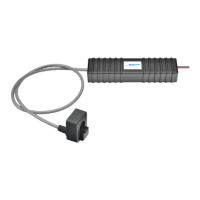18
Curtis 1030 Acuity Manual, Rev. C
SDO Response (SDO-MISO)
An SDO request is always acknowledged with a response message from the
Acuity. The Acuity can issue two kinds of response messages: a normal response
or, in case of an error in the request SDO, an Abort SDO Transfer message.
SDO-MISO
(sent by the Acuity in response to the system master)
Byte 1 Byte 2 Byte 3 Byte 4 Byte 5 Byte 6 Byte 7 Byte 8
Control CAN Object Sub-index Data: either the requested Read values,
Index or the actual Write values, or an error code
The first data byte of the response contains an acknowledge code, which
depends on the type of transfer that was initially requested.
Action
Byte 1
Value
Read Response 40h
Write Acknowledge 60h
Abort SDO 80h
Data bytes 2, 3, and 4 hold the CAN Object index and sub-index of the
request SDO.
If the SDO was a read command (a request for data from the Acuity),
data bytes 5 through 8 will be filled with the requested values, with the least
significant byte is data byte 5 and the next least significant in byte 6 and so
forth. All unused bytes are set to 0.
If the SDO was a write command, data bytes 5 through 8 will return back
the actual value written in bytes 5
– 8. In this way, if the Acuity needs to limit or
round-down the SDO write request, the master will know—because the return
value will be different than the sent value.
If the SDO-MOSI did not properly read or tried to access a parameter
improperly, an Abort SDO Transfer will be sent. Data bytes 5 through 8 will
be filled with a 32-bit error code:
06020000h = Object does not exist
06010002h = Attempt to write to a read only object.
Types of SDO objects
There are three types of SDO objects: Communications Profile Objects (address
range 1000h), Device Parameter Objects (address range 5100h), and Device
Monitor Objects (address range 5200h). Communications Profile Objects are
described in this section; Device Parameter Objects and Device Monitor Objects
have sections of their own. The following definitions apply to all the objects.
Access RO = Read Only access. RW = Read/Write access.
Index The CAN address that is used to access this object.
Sub-index Some objects have several associated values. In these cases,
a sub-index is used to access each component of the object.
6 — SDO COMMUNICATIONS

